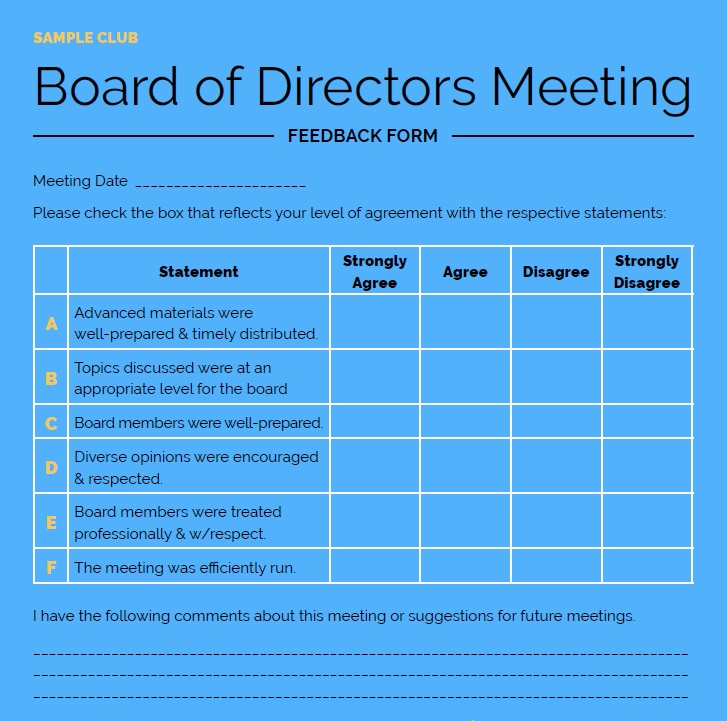Board member surveys frequently reveal they would like shorter, more efficiently run meetings. Upon investigation, we learn that these clubs are not using basic practices that can reduce the
duration of meetings without compromising their content or the interaction among board members. Club boards should document these best practices in their board policies manual (BPM). Not only does the BPM prescribe the overall style of the board in terms of its strategic focus, the conduct of its board members and its commitment to continual improvement, but it includes policies describing the way meetings will be conducted. In this article we give explanations of best meeting practices along with actual BPM policies (in italics) documenting the practices.
Meeting Preparation
Efficient meetings require good planning by the president and the general manager and good preparation by the members. Planning for the meeting must include the agenda and related materials needed to prepare board members. If the agenda includes committee reports, committee chairs must be alerted to the deadline for the materials to be sent to board members prior to the meeting.
Example Policy: The GM will assist the president in developing board meeting agendas and no later than three days in advance of the board meetings, will send to board members the meeting agenda and background materials such committee reports, minutes of the
previous meeting, financial statements and other materials related to agenda items.
Consent Agenda
There are portions of the agenda that typically do not require a discus- sion before board approval at the meeting, e.g., minutes of a prior meeting, financial reports, committee reports. Rather than address each of these items separately (e.g., requesting motions and seconds and voting on each item), include them on a consent agenda, which requires only that the board members be alerted to the items on the consent agenda. If any board member wants to amend or discuss an item on the consent agenda, it is removed and placed on the meeting agenda for discussion. In addition to reducing meeting time, this practice encourag- es board members to prepare for the meeting by reading pre-meeting materials and sharing any suggested amendments prior to the meeting.
Example Policy: The president will employ a “consent agenda” for all regular meetings. The president will include in the advance material a separate list of items on the consent agenda. At the beginning of each board meeting, any item on the consent agenda will be removed at the request of any board member. Otherwise, the items on the list will be deemed approved without a formal motion or vote.
Meeting Management
It is not unusual for a club’s bylaws to require the use of Robert’s Rules of Order, a manual of parliamentary procedure by U.S. Army officer Henry Martyn Robert, for its meeting management. However, Robert’s Rules are complicated and rarely understood by board members. We therefore recommend the adoption of a general rule pertaining to meeting management, one that leaves to the chair (president) the discretion of running the meeting. If there is a question of the chair’s decision on a matter, it is settled by a simple majority vote.
Example Policy: The president will conduct meetings in a fair manner that encourages open and honest discussion and thoughtful consideration of the views of each board member. If a board member challenges a ruling of the president, the matter will be settled by a
majority vote of the members. Where possible, the president will seek a consensus on decisions and policymaking. If a vote is highly contested, the president may defer a vote on the matter until the next board meeting, thus providing additional time for board members to consider the matter before taking action. Where the timing of a decision dictates, however, the president may call for and accept a vote when there is no clear consensus.
Meeting Evaluation
Although this practice is, sadly, seldom done, it is a highly effective way to provide timely feedback on the quality and efficiency of board meetings. A simple online survey, anonymously conducted and requiring no more than five minutes to complete, will inform the chair how his/her colleagues rate the quality of the board meetings. It will also equip the chair with data on, say, possible board members who need reminding not to dominate the discussion. Although it takes a president who holds himself/herself accountable to the other board members, the result is a responsibility to conduct efficient and effective meetings shared by the entire board.
Example Policy: Within three days following the board meeting, each board member shall complete an online meeting evaluation as shown on Appendix X of the BPM [sample shown nearby]. While the summary results of the survey will be shared with the board members, individual responses will be kept strictly on confidential.
Club boards comprise volunteers who are willing to give their time and talents to carry out their fiduciary duties. Most boards meet once a month with a meeting length that varies with the content and the process used to manage the discussion. board presidents owe it to their colleagues to make efficient use of their time in board meetings. The above policies have proven effective in reducing the length of board meetings and nurturing respectful interaction among board members without reducing the amount of business conducted. Moreover, board chairs that have the temerity to solicit feedback on the quality of their meetings will gain the respect of their fellow board members and in the process pick up ideas on managing board meetings.



